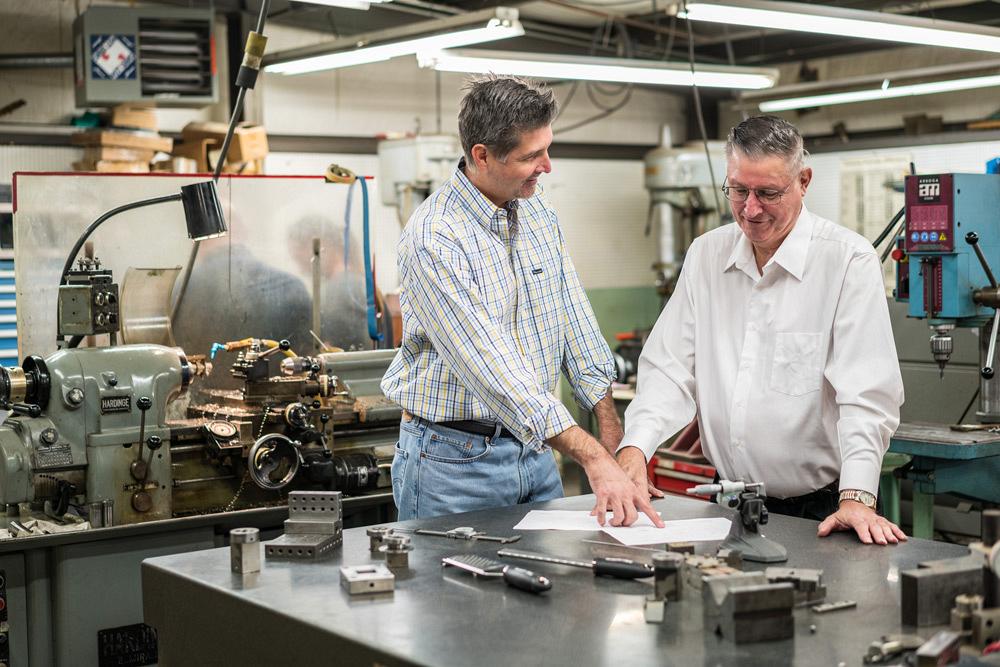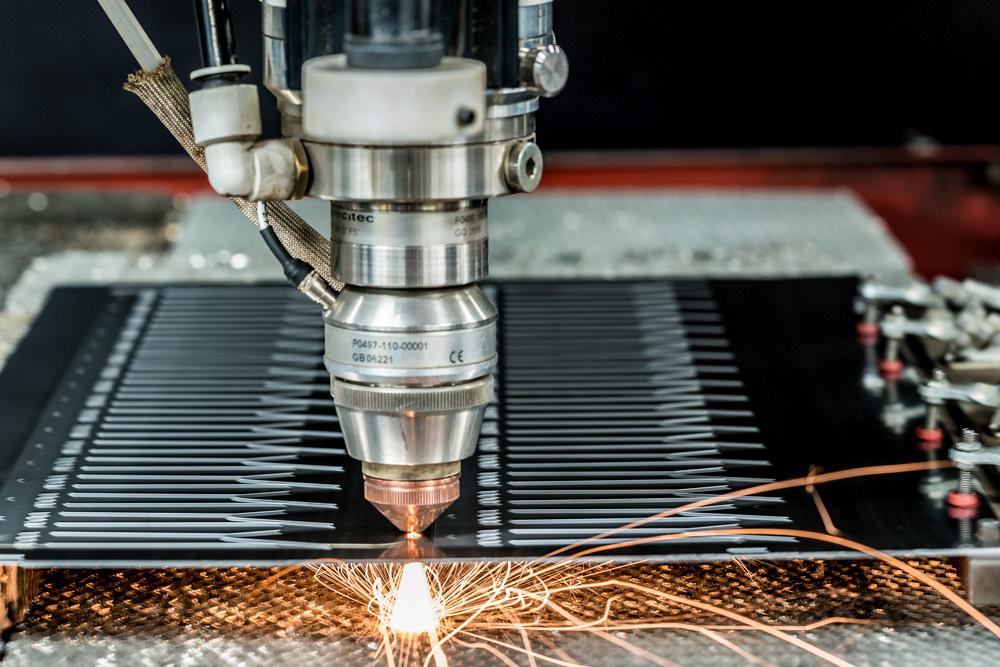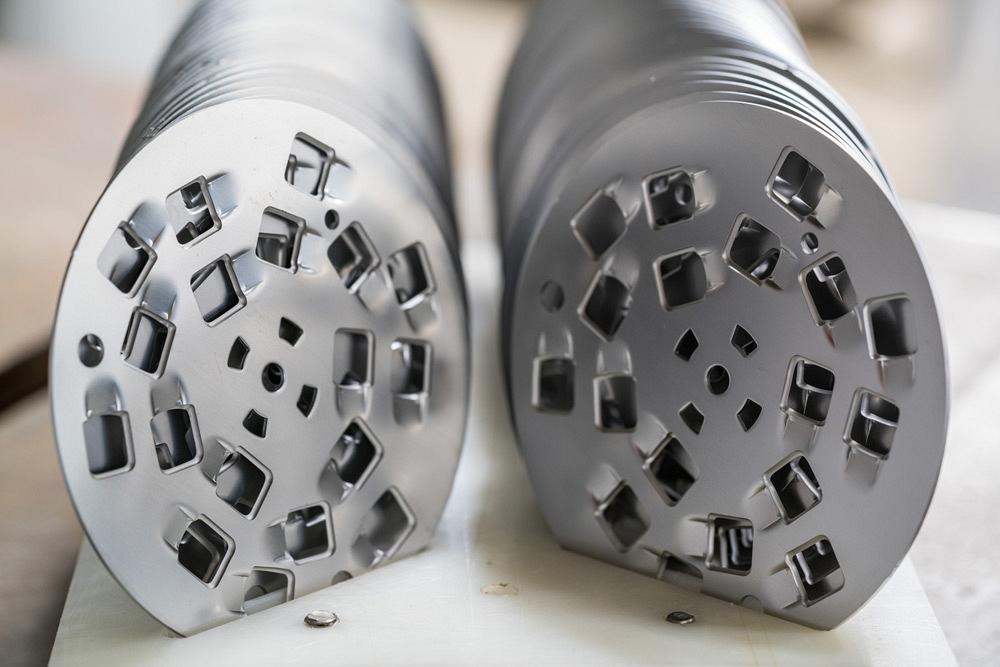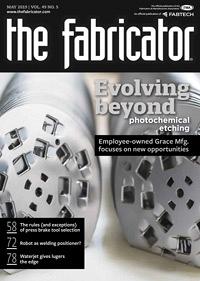Senior Editor
- FMA
- The Fabricator
- FABTECH
- Canadian Metalworking
Categories
- Additive Manufacturing
- Aluminum Welding
- Arc Welding
- Assembly and Joining
- Automation and Robotics
- Bending and Forming
- Consumables
- Cutting and Weld Prep
- Electric Vehicles
- En Español
- Finishing
- Hydroforming
- Laser Cutting
- Laser Welding
- Machining
- Manufacturing Software
- Materials Handling
- Metals/Materials
- Oxyfuel Cutting
- Plasma Cutting
- Power Tools
- Punching and Other Holemaking
- Roll Forming
- Safety
- Sawing
- Shearing
- Shop Management
- Testing and Measuring
- Tube and Pipe Fabrication
- Tube and Pipe Production
- Waterjet Cutting
Industry Directory
Webcasts
Podcasts
FAB 40
Advertise
Subscribe
Account Login
Search
How a growing manufacturer became an ESOP
Having skin in the game matters at Grace Manufacturing
- By Tim Heston
- May 2, 2019
- Article
- Shop Management

Chris Grace (left) reviews a print with his father Richard Grace. Chris took over the business in 2011, and earlier this year the Grace organization became an ESOP.
A fabricator’s roundtable at this year’s Fabricators & Manufacturers Association Annual Meeting, held in March in Nashville, brought up myriad topics, from the impact of fiber laser technology to advances in software. But near the end of the conversation, most roundtable participants agreed that success in fabrication doesn’t hinge on having a particular laser cutting machine or press brake. It hinges on culture.
Chris Grace, president and CEO of Russellville, Ark.-based Grace Manufacturing, agrees. Grace Mfg. offers laser cutting, photochemical etching, plastic injection molding, and wire electrical discharge machining (EDM)—an unusual combination that gives Grace a competitive edge for specific customers. The company also doesn’t lack in expertise, being known for its etching capabilities, particularly for the medical field.
Yet etching surgical products really just scratches the surface of the Grace organization. Martha Stewart—yes, that Martha Stewart—uses and wholeheartedly recommends one of Grace Mfg.’ signature products. And in recent years Grace Mfg. has acquired various companies. It bought a small machine shop in Lodi, Calif. It also acquired several medical instrument players, including Greenwald Surgical, an Indiana manufacturer of urological and electrosurgical instruments. Most unusual, Grace acquired Sweet Dreams, a company in a completely unrelated field—high-end bedding and related soft goods. All told, the company has 110 employees working at its Arkansas plant and 215 employees working at other facilities in the U.S. and in Mexico.
Chris continues to build a diversified asset portfolio. Thing is, it’s now not just for him and his family. This year Grace became an ESOP, a company owned by an employee stock ownership plan. The better the company does, the better employees do financially.
“Chris is a true entrepreneur,” said Cedar Rapids, Iowa-based Hillary Hughes, director, Prairie Capital Advisors Inc., which facilitated Grace’s ESOP transition. “He’s been incredibly successful. You can read about diversified acquisition strategies across different business platforms and the theoretical benefits of doing it, but you don’t see a lot of companies actually executing on that.”
Chris didn’t form the ESOP as an exit strategy. He’s 48, and his two children aren’t yet teenagers. Chris calls himself a “true believer” in the Great Game of Business, a business consultancy owned by Jack Stack, a onetime CEO in the steel business (and keynote speaker at an FMA Annual Meeting several years ago) who promotes financial transparency and giving everyone skin in the game—which happens to be what an ESOP is supposed to do.
Worth a Four-hour Wait
Chris’s father, Richard Grace, hadn’t made an appointment at 3M Surgical in California. Truth was he couldn’t get anybody to return his phone calls, and this being the early 1980s, he had no emails or cell numbers to try either. So he simply flew out and showed up in the lobby. After four hours of waiting, an engineer finally emerged from the back offices.
As Chris explained, “He told Dad, ‘You etchers are all the same. You all think you can etch a bone saw, but we haven’t seen anybody be able to do it.’ And so my dad said, ‘Well, give me a print and I’ll make some samples. It won’t cost you anything.’ So the guy gave him a print. He flew back, and about six weeks later some parts showed up on the guy’s desk. He called immediately and asked my dad, ‘When can you guys come back here?’”
If Richard hadn’t waited in that lobby, Grace probably wouldn’t be the diversified company it is today. Long before tackling orthopedic bone saws, the manufacturer made type slugs for impact printers in the early computers of the late 1960s and throughout the 1970s. Instead of a pin hammering a dot—as was done with dot matrix systems, the most well-known type of impact printers today—these early impact printers used individual type slugs, one for each font type and size, which Grace Mfg. manufactured with EDM.
Impact printing technology then evolved and started using what was known as type bands, which were small, 0.015-in.-thick strips of metal with etched (not EDMed) type characters. This set Grace Mfg. down the path of photochemical etching.
Photochemical etching can etch partway through the sheet thickness to create geometries like a channel or pocket or throughout the entire thickness to create a kerf. To start, a pattern is printed onto a photographic film, a photonegative of the final part that shows the kerfs and etched pockets and channels in blue. This so-called “photo-tool” is adhered to both sides of the sheet metal blank, which is treated with a UV-sensitive coating called a photoresist. The plate is exposed to UV light, which develops the pattern, protecting the solid sections from acid. It then goes through a machine that sprays acid to etch or completely remove the unprotected sections.
Moving Beyond the Impact Printer
While the impact printing business kept Grace Mfg. busy in the 1970s and early 1980s,its future didn’t look bright, mainly because the shop made most of its money in a product that was going obsolete.
“Those types of impact printers [that used the print bands] were going away,” Chris said, “and our customers told us, ‘Hey, this is the end of the line. The new printers are all electronic.’ These impact printers had a long service life, though, so it was a gradual decline in sales. But knowing this wouldn’t last forever, my father started looking for something else to keep the factory running.”
By this time the company was etching everything from rulers to decorative boot tips. These and other jobs like them probably would have been fine for a specialty etching job shop, but they didn’t entail the kind of demand that could grow the company. Richard thought that if a small photochemical etcher in Arkansas could break into the surgical bone saw market, where no other etcher had gone before, Grace’s path would be forever changed. So when he couldn’t connect with engineers at 3M Surgical, he didn’t hesitate to buy a plane ticket and head out to California with no appointment. To say that bet paid off is an understatement.
From Etching to EDMing to Laser Cutting
Fabricating the saws requires not only precision cutting of the tooth geometries and saw perimeter, but also precision forming of cooling channels, which distribute frictional heat during cutting.
In the 1970s and early 1980s, bone saw manufacturing required complex hard tooling, especially expensive because it had to be amortized over low quantities—hence the attractiveness of photochemical etching.
Etching them was, and remains, a technical feat. Bone saws are not only made of stainless steel, which itself isn’t the easiest to etch, but are also 0.050 in. thick. In the 1980s etching bone saws required two passes. For the first setup the photo-tool etched 0.005 in. down to create surface features; the technician then flipped the blank to etch features on the other side. These two steps comprised the first pass of the etching. For the second pass, the technician removed the blank, cleaned it, changed the photo-tool, then aligned everything perfectly to etch the saw perimeter and teeth.
“There are some tricks to this, because you must have everything aligned perfectly between your first pass and second pass,” Chris said. “It’s usually hard enough to get front and back images close [in the first etching pass]. But now you’re etching features with two different passes; it can take you from algebra to calculus real quick.”
Two-pass etching was and remains an extraordinarily difficult process, but it still made business sense considering the savings realized by avoiding hard tooling, especially when it came to the tooth geometries and various pitches.
By its nature, etching leaves a residue on the cut edge that must be cleaned, an especially critical process for the teeth (what technicians call “the business end” of the saw). Engineers eventually found that they could simplify the cleaning step by cutting the actual teeth using a wire EDM. But wire EDM is slow, so though it made sense to cut the teeth, it didn’t make sense to cut the remaining perimeter of the saw, which was still done with that challenging second etching pass.
By the 1990s company techs had their eye on a rapidly growing technology in metal fabrication: laser cutting. The idea was to eliminate the second etching pass and simply have the laser cut both the bone saw’s teeth and its perimeter.

Grace Mfg. offers tight-tolerance laser cutting. The workpiece here is fixtured in place with toggle clamps.
The company eventually invested in five 2-kW CO2 laser cutting machines with an unusual setup. They didn’t have flying optics. Instead, the cutting head moved in Z while the cutting table itself moved in X and Y.
“This gave us the tight tolerances we needed,” Chris said. “In fact, years later we looked at a newer laser cutting machine with flying optics, and it was so much faster, but it wouldn’t give us the same tolerances.”
Most recently the company upgraded to a high-precision fiber laser cutting system that’s much faster than the older machines, thanks to an advanced vision system that helps mitigate the effects of thermal growth from etching. This isn’t the same as thermal growth in laser or plasma cutting, but instead has to do with the growth of the photo-tool after repeated use in a run.
“After numerous etching cycles, the photo-tool heats up and starts to expand,” Chris explained, adding that this ever-so-slightly changes the position of etched features throughout a batch of sheets. Here, the laser cutting machine’s vision system detects the position of those features, then corrects the cutting program to account for that slight variation.
Enter Martha Stewart and Julia Child
Now for something completely different. While Grace’s bone saw fabrication evolved, serendipity took hold.
In 1984 Richard perused the woodworking aisle of a local hardware store and saw rasps of various shapes and sizes. He could tell that the metal on them was probably made with a hard tool, and the edges weren’t particularly sharp—certainly not like the sharp edges an etching process could produce.
So he returned to the shop and developed a unique etching process that he eventually patented, trademarking the name Microplane™. Thin stainless steel undergoes a photochemical etch. The etched sheet is cleaned and then placed on a tool that pushes the individual blades upward slightly (a process called “setting the teeth”). The sheet is then formed into the desired shape. The resulting tool is assembled to a plastic component, made in-house via plastic injection molding.
What emerges from all this is a tool that looks not only like an effective finishing tool for the carpenter but also a high-end grater for the cook (though in the 1980s the Grace family really wasn’t thinking of cooking).
“By the 1990s we were selling the Microplane through a catalog company and hardware store called Lee Valley Tools,” Chris said. “And as the story goes, Mrs. Lee [who owned Lee Valley Tools with her husband] was baking an Armenian orange cake and she needed orange zest. She tried her box grater and thought, ‘Well, this is terrible.’ And so she thought, ‘I wonder if I could use my husband’s Microplane? He’s been telling me about how sharp the teeth are.’ She went in his wood shop, got the Microplane, washed it, and tried it. And she immediately found that it was perfect for zesting, because it cut just the very top portion of the peel. So in the next issue of the catalog, next to a picture of the Microplane, instead of having a picture of wood carvings, it had pictures of shaved citrus, chocolate, and garlic. And the slug line read something like, ‘The Microplane works great on wood, even better on food: great for zesting and grating hard cheeses and chocolates.’”
A few weeks later Grace Mfg. received an unexpected purchase order. Marketed as a woodworking tool, normal order volumes entailed just a few hundred pieces. That month the PO was for 10,000.
At this point Chris had just graduated from college and was helping out in the front office. This being 1994, Chris was asked to retrieve some recently faxed orders. “I remember seeing the fax, and I knew I had to call them immediately. I asked, ‘Is there a typo here?’ They said, ‘No, that’s right. We need 10,000 pieces.’ And I asked, ‘How is this possible? What happened?’ ‘Well,’ they told me, ‘you’re never going to believe this, but we’re selling them as cheese graters.’”
The catalog company sold these Microplane “graters” to a specialty gourmet shop called The Broadway Panhandler. As Chris explained, “Martha Stewart and Julia Child were going in there, buying them by the case and sending them to all of their friends, saying, ‘You’ve got to try this.’”
Not long after, The New York Times food section published an article about how the woodworking tool Richard Grace invented had found a home in the kitchen. The Associated Press picked up the story, and soon home cooks across the nation were visiting their kitchen supply stores and asking for a product that the sales clerks had never heard of.
“By the way, all this is happening unbeknownst to all of us,” Chris recalled. “No one in my family even likes to cook. But after all this, our Microplane sales went from $10,000 a month to $100,000 a month, pretty much overnight.”
Today the Microplane patent has expired and some of the product’s production has moved to Grace Mfg.’s facility in central Mexico. The sheets still are etched in the U.S. but then are shipped flat to the Mexican facility, where the tooth setting takes place in a stamping die. The pieces are transferred to a forming press that bends the sheet to the desired shape, which is then assembled to plastic handles, inspected, and shipped to distributors.
Skin in the Game
Between 2008 and 2011 Chris and his wife took ownership of Grace, and around that time someone gave Chris a book called The Great Game of Business by Jack Stack. Chris attended a training class on Stack’s Great Game of Business (GGOB) management method, but the company’s finances weren’t great, and so he thought it wasn’t the best time to implement the method—an unusual step, considering Stack’s method often is used in turnaround situations. But according to Chris, the financial problems Grace endured in 2011 weren’t self-inflicted; like most other manufacturers, the company was still recovering from the effects of the Great Recession. So he kept the book in his nightstand.
In 2016 Chris then went on a business trip and turned to his nightstand for something to read on the flight, and there was The Great Game of Business. “I read it, and then I thought, ‘We are in a much better place financially, and this is something we can implement now.’” The company’s contract manufacturing division, which includes the orthopedic bone saws and other etched parts for various industries, dove into the program first.
GGOB has many components, one major one being that it opens up the books and educates employees on the basics of finance. Another key component: The better the company does financially, the better employees do financially as well. To that end, when Grace launched GGOB three years ago, it implemented bonus programs based both on profits before tax (PBT) and cash flow.
“We trained every employee on how finance works,” Chris said. “And I did much of the training, asking them, ‘Of every dollar we ship, how much do you think I get to put in my pocket?’” Answers ranged from 25 percent to 75 percent. “With this, I quickly realized many people have no idea of the reality. So per GGOB, we showed them how the rules of business work. We showed them the profit and loss statement and the cash flow statement.”
During weekly huddles, employees view the finances and work together to predict what revenue will be for the next month. “It’s a forecast,” Chris said. “Sales looks at the open orders, and they talk with production to see what orders will ship. Everybody predicts what expenses will be, and we do a P&L statement. So when everyone leaves the meeting once a week, they have an idea how the month is going to turn out.”
As Chris explained, when everyone not only had access to the numbers, but knew how to read and act on them, the shop culture started to change. People were less tolerant of employees who didn’t pull their weight. They also saw the value of reducing overtime and scrap rates. The less of each they incurred, the better the company would perform, and the bigger their bonuses would be.
“And on the Microplane side of the business, my customer service team has always wanted lots of finished goods inventory,” Chris said. “But now that their bonus is based on cash flow, it makes them think twice about having all the inventory in the world.”
In Stack’s first book and GGOB follow-up books, he mentions ESOPs as a way to give employees true skin in the game. So with that, Chris attended conferences and began working with Prairie Capital Advisors to facilitate the ownership transition.
According to Prairie’s Hillary Hughes, Grace Mfg.’s choice to become a 100 percent ESOP immediately isn’t unusual. Because Grace Mfg. is an S Corp. that transitioned ownership to an ESOP, it enjoys some significant tax benefits. But what is unusual is the fact that Chris Grace—again, just 48 years old—isn’t using ESOP as an exit strategy.
Chris remains CEO and chairman of the board, and he won’t stop working to grow the business organically or through a diversified acquisition strategy. But as of this year Grace Mfg. is no longer a family enterprise; the ESOP owns the company. Along with receiving a specified number of ESOP shares every year, employees participate in a 401(k) plan and make other investments, so they’re not placing all their eggs in one basket.
Chris and his wife didn’t use any bank debt during the transaction. They instead took seller paper (like promissory notes) that will be paid back with interest over 20 years. “They wanted to make sure employees got the best deal possible,” Hughes explained. “I wouldn’t say bank debt is risky, but it does come with covenants.”
Chris conceded that this comes with risk, especially if things go south and everything falls apart. “We’ll basically be holding pieces of paper that aren’t worth anything.”
Of course, he emphasized that his family didn’t simply give the business away; they will be financially secure, especially as the payments go as planned over the years. All the same, the arrangement has meant that Chris, like his employees, has skin in the game.
As Chris sees it, that skin in the game builds something that can’t be copied, become obsolete, or undergo patent expiration. It’s something that, according to many fabricators, matters more than specific business processes or fabrication technologies. It’s an engaged company culture.
About the Author

Tim Heston
2135 Point Blvd
Elgin, IL 60123
815-381-1314
Tim Heston, The Fabricator's senior editor, has covered the metal fabrication industry since 1998, starting his career at the American Welding Society's Welding Journal. Since then he has covered the full range of metal fabrication processes, from stamping, bending, and cutting to grinding and polishing. He joined The Fabricator's staff in October 2007.
subscribe now

The Fabricator is North America's leading magazine for the metal forming and fabricating industry. The magazine delivers the news, technical articles, and case histories that enable fabricators to do their jobs more efficiently. The Fabricator has served the industry since 1970.
start your free subscription- Stay connected from anywhere

Easily access valuable industry resources now with full access to the digital edition of The Fabricator.

Easily access valuable industry resources now with full access to the digital edition of The Welder.

Easily access valuable industry resources now with full access to the digital edition of The Tube and Pipe Journal.
- Podcasting
- Podcast:
- The Fabricator Podcast
- Published:
- 04/16/2024
- Running Time:
- 63:29
In this episode of The Fabricator Podcast, Caleb Chamberlain, co-founder and CEO of OSH Cut, discusses his company’s...
- Industry Events
16th Annual Safety Conference
- April 30 - May 1, 2024
- Elgin,
Pipe and Tube Conference
- May 21 - 22, 2024
- Omaha, NE
World-Class Roll Forming Workshop
- June 5 - 6, 2024
- Louisville, KY
Advanced Laser Application Workshop
- June 25 - 27, 2024
- Novi, MI



































